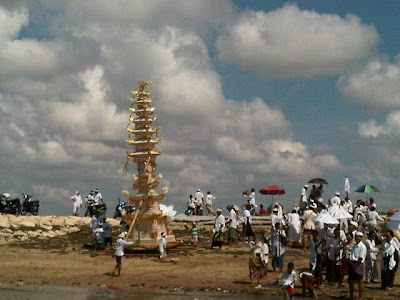Taken from ‘Bungklang Bungkling’, ‘Suci’, a column by I Wayan Juniartha, published in Bali Post, Sunday 24th October 2010. Translated by Putu Semiada

Suci (Holy)
There has been a hot discussion at the palm toddy warung. It is between I Made Nyineb Wangsa (I Made Upgrade His Clan Status) and Ni Luh Makin Digosok Makin Sip (the More You Rub Her The More She Loves It).
“Give me a new bottle, the one that has never been used before (sukla) and holy (suci),” says I Made.
I Made has been looking for his ‘kawitan’ (ancestor origin). And just by the new year he found the manuscript.
The manuscript confirms that I Made belongs to Ksatriya caste in the old times, he belongs to ‘Tri Wangsa’ (the three higher caste). Even all of his family members have changed their names too, to show that they are higher caste. They add ‘Anak Agung’ to their names. Made’s name now become Anak Agung Gdé Agung Ngurah Gdé (AAGAGNG). He even wants to add Shri Shri before Anak Agung. But his relatives don’t seem agree with him as it sounds ‘girlish’ (similar to Sri).
Made’s friends even have ‘slip-tongue’ when they call his name. He will ignore anyone who calls his name without adding ‘Ratu’ (like a mayor who thinks himself a king, or vise versa). Or at least one has to call him ‘Gung Dé’, otherwise he will not look at you. When there is a ceremony (karya) in the temple, he doesn’t do anything to help. He just sits in the pavilion (bale), wear a protruding headdress (udeng) and pretends to be a village elder. The way he has meals is not like everybody else anymore (Balinese squat instead of sitting when they have meals in the temple). And he has to use a food stand (dulang) too when he has meal.
“It’s a clean bottle, you know. It has been washed using rinso (detergent powder) and clean water. I also bless my kitchen wares with holy water (tirta) from priest’s house (geria). Isn’t that enough for you?” Ni Luh gets mad.
AAGAGNG’s eyes bulge out as he gets very angry that Ni Luh gives him an ‘unholy’ bottle and she dares to speak in ‘lower’ language to him in spite of his new ksatria status.
“What an uneducated person you are, you know ‘holy’ is difference from ‘clean’. No matter how many times you have washed the glass, but when you have used it for somebody, it is not ‘holy’ (sukla) anymore,” argues Ida Anak Agung.
Everyone nods. Ida Anak Agung looks happy as he smiles widely. He feels that everyone agrees with him. He feels like a king surrounded by his assistants.
“It is exactly right, your highness… ‘Clean’ is not the same as ‘holy’. We have a lot of sample of this. Look at the Legislative members. Their clothes, teeth, skin are clean, but they are not ‘holy’. Look at them. They go far away to Greek just to study about ethics. It means that they can not behave properly, nor control their attitude and desire, which means that are not holy,” says I Ketut Simbing Nyindir (I Ketut Sarcastic).
Everyone laughs. It seems that I Ketut is trying to tease AAGAGNG.
“’Clean’ is outside, but ‘holy’ is inside. So when something is ‘unholy’ you can not ‘clean’ using rinso.”
AAGAGNG realized that even he has changed his status to ‘Anak Agung’, but his ‘brain’ has not improved much yet. No matter if you have gained royal degrees, how big is your ‘palace’, but if your brain has not been improved, it will be useless; like what happens to AAGAGNG. Just when I Ketut criticizes him, he has no proper arguments.
“Clean heart, clean mind and clean behavior is the way how you can make your self ‘holy’.”
As glass is not a human, it can not clean itself. Even it’s new, it is just ‘clean’ but not ‘holy’.
It is similar to ‘unholy’ and ‘dirty’. They have different meaning. However, it is kali yuga age, where ‘unholy’ and ‘dirty’ are mixed. As you can see, among Balinese, they fight in the temple before praying, some even wear temple dress and pray at the temple before burn their Balinese fellow’s house; we even heard about some Balinese kick the temple’s door to be able enter the temple, and some Balinese fight among themselves just because a dead body (sawa). That’s what we call ‘unholy’ (cemer) and ‘dirty’ (kotor).
It’s not just ‘unholy’ (cemer) and ‘dirty’ (kotor) but it’s really really a stupid thing. Under this circumstance, who dares to claim himself to be high caste or high kstaria?



































































